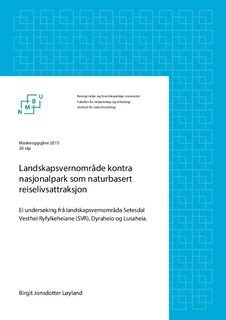| dc.description.abstract | Denne oppgåva tek for seg lokale aktørar innan naturbasert reiseliv i nærleik til dei tre
landskapsvernområd
a Setesdal Vesthei Ryfylkeheiane, (SVR) Dyraheio og Lusaheia og korleis
dei oppfattar ei mogleg oppretting av n
asjonalpark i delar av områda. Fleire
lokalpolitikarar
og representantar
frå forvaltinga at nasjonalparkstatus har uttalt at etableringa av ein
nasjonalpark kan få positive effektar for reiseliv
.
N
asjonalpark
prosessen
er per mai 2015
f
ramleis på eit tidleg stadium og det er ikkje mykje tilgjengeleg informasjon om temaet.
Ettersom mykje av forskinga som er gjort innan naturbasert reiseliv omhandlar
etterspurnadssida
, er
det av interesse å undersøke tilbodssida sitt syn på ein eventuell
nasjonalpark.
Det vart nytta
ein parallell metode der informantane fyrst svarte på eit
spørjeskjema og dermed vart intervjua om
korleis dei oppfattar noverande verne
form og ein
eventuell nasjonalpark
. Resultata frå båd
e spørjeskjema og intervju syner
at eit fleirtal av
informantane føretrekk verneforma nasjonalpark framfor noverande verneform
.
Landskapsvernområdestatus vert oppfatta som lite fordelaktig med omsyn til
næringsverksemd i verneområda, og er prega av strenge restriksjonar. I tillegg vert
landskapsvernområde oppfatta som eit lite etablert omgrep som i lita grad nyttast i samband
med marknadsføring. Resultata syner at samtlege informantar trur
nasjonalparksta
tus vil føre
til høgare besøkstal både
i berørte område og
for si eiga
verksemd/organisasjon og at
nasjonalparkstatus vil ha positive effektar
med omsyn til marknadsføring.
Resultata vart tolka
i ljos av teoriar om attraksjonar og attraksjonssystem, der e
in attraksjon består av tre
komp
onentar; ein kjerne (t.d. ein sjåverdigheit, objekt,
arrangement
) ein
markør (dvs.
informasjon om e
in sjåverdigheit). Hovudfokuset var på markørkomponenten i
attraksjonssystemet
.
På bakgrunn av funna i studiet kan landskapsv
ernområdestatus verke
å
vere av lita verdi som markør
for tilboda til informantane og området generelt
.
Informantane
oppfatta nasjonalpark som
ei
n
meir
etablert vernestatus, særleg i forhold til utanlandske
turistar, og dermed av større verdi mot. marknad
sføring. Dette kan indikere at
nasjonalparkstatus i større grad har moglegheit til å fungere
som ein markør som gjer området
attraktivt for turistar. Abstract
The theme of this master thesis is local stakeholders within nature
-
based tourism in relation
t
o the following protected landscape areas; Setesdal Vesthei Ryfylkeheiane (SVR), Dyraheio
and Lusaheia protective
area
, and their expectations to the potential establishment of a
national park within the areas. Several local politicians and conservation re
presentatives have
stated that tourism could benefit from such an establishment.
As of May 2015, the national
park proce
ss is still at an early stage and limited amounts of information exists on the subject.
As m
ost research within the field of nature
-
bas
ed tourism focus
es on the demand side
, I
wanted to present the supply side of nature
-
based tourism and their expectations to the
potential establishment of a national park. A combined method of questionnaires and semi
-
structured interviews was utilised in
order to
examine how the informants perceive the
current conservation category compared a national park
.
Results from the survey and
interviews show
ed that most of the informants prefer
national park designation
instead of
the
p
rotected landscape area stat
us, as t
he status is perceived to limit tourism activity
.
As for
marketing purposes, the term protected landscape area is much used.
A majority of the
informants
believed that national park designation would lead to an increase in visitor
numbers for both
their own business/organisation as well as
the area in general. All
informants
believed that a national park designation would have a positive impact on
marketing.
Results were discussed in relation to tourism theo
ries on attractions
consist
ing of
a nucle
us (e.g. a sight, object, or event),
a marker (i.e. information about a sight) and a tourist.
The main emphasis was on the marker component of the attraction system. The results imply
that t
he current
conservation category
protec
ted landscape area has a li
mited ability to
function as a marker. A majority
of the
informants believed that the term
national park is more
established, especially amongst foreign visitors
,
and
therefore more effective in terms of
marketing. This may imply that a national park desi
gnation has the ability to function as a
marker. | nb_NO |
